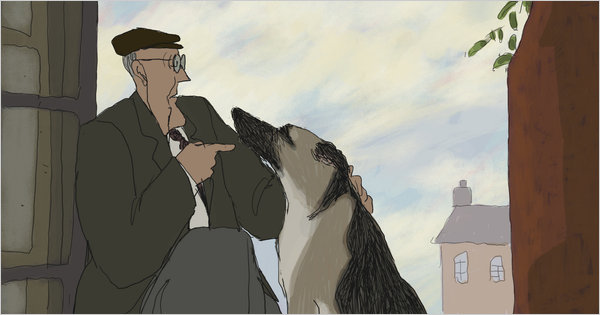|
Reviews of Recent Independent, Foreign, & Documentary Films in Theaters and DVD/Home Video

MY DOG TULIP Though it was completed made in the U.S.A, this vibrant animated film has retained the thoroughly British tone of J. R. Ackerley’s 1956 memoir, a first-person love letter to his loyal Ideal Friend, an Alsatian bitch, Tulip. In fact, the droller-than-droll delivery of Ackerley’s mordant stream-of-consciousness frequently outshines the animation. The film’s wry charm is due in no small part to the versatility of Canadian-born Christopher Plummer’s narration as well as to the voice work by the late Lynn Redgrave. The dialogue would easily be adaptable as a one-man show, which I’m sure Plummer has considered. (Pennsylvania-based directors Paul and Sandra Fierlinger have paid penance for the sins of faux-Britannia committed in other American films—like Dick Van Dyke in Mary Poppins and Winona Ryder in Bram Stoker’s Dracula.) A lonely, middle-aged bachelor, the onscreen Ackerley takes the 18-month-old dog off the hands of a working-class couple who had confined the highly intelligent animal, bred for herding sheep, in a small yard. That explains why the barking machine has no sense of how to behave in the outside world. High maintenance doesn’t begin to describe her behavior: the accidental biting, the indiscriminant defecating, Tulip and Ackerley’s sister battling over who’s the mistress of the house, etc. But more than a third of the film obsesses, like Ackerley, over Tulip in heat. He wants her to experience the joys of a dog’s life, but what canine wound be good enough to mount her? A gauntlet of dogs—basset hound, poodle, the odd ragamuffin—chase after her tail, all in vain. (Here, Tulip’s drawn like a film star under siege by paparazzi.) I’m not even going to mention what her owner strangely proposes to do with her eventual litter. He doesn’t proceed with his plans, though. When he notices Tulip “fouling the flat,” he gets the hint and stops. (Ackerley’s real-life dog was named Queenie, but the name was allegedly changed in the book to discourage snickering about Ackerley’s homosexuality. He was quite out for the time.) With more droppings than in a dog park, the ever-morphing animation is just as unsentimental as the narration—Tulip’s anal glands are ready for their big screen close-up. An entirely hand-drawn and painted film utilizing computer technology (that is, it’s digital), the look is reminiscent of Quentin Blake’s jagged pen-and-ink drawings. Though set in the postwar period that’s often depicted in film in drab drowns and grays, the directors splash colors—from the tried-and-true icons of the flaming red mailboxes and double-decker buses to a pastel-green countryside. Ackerley’s black-and-white imagining of an anthropomorphized Tulip looks as rudimentary and childlike as Ian Falconer’s children’s book character Olivia. Scampering
from episode to episode, Tulip heavily
depends on the anecdotal voice-over. Though it’s refreshing that the
film celebrates dogs without resorting to dead-dog drama,
there’s little narrative variation and not much of a dramatic arch. Cat
lovers might remain imperturbably aloof, but it’s a delightful
sermon for the choir. All together now, to the melody of the film’s
angelic chorus, which goes something like this: “You smell my hole, I
smell yours.” Kent Turner
|

